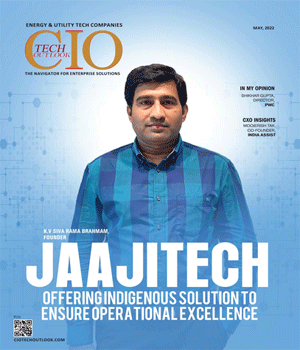
Technology: The New Disruptor For Indian Real Estate
Anuj Puri, Chairman & Country Head, JLL India | Friday, 16 June 2017, 11:09 IST
 Tech is disrupting the transaction life cycles of real estate asset classes in India, and could soon start transforming real estate requirements too. First, computers arrived, then the Internet; both revolutionized the world. Even today, IT continues to democratise the world as also catalyse the introduction of several new services and products across the globe. In India too, IT-based start-ups continue to disrupt old ways of doing business in many sectors.
Tech is disrupting the transaction life cycles of real estate asset classes in India, and could soon start transforming real estate requirements too. First, computers arrived, then the Internet; both revolutionized the world. Even today, IT continues to democratise the world as also catalyse the introduction of several new services and products across the globe. In India too, IT-based start-ups continue to disrupt old ways of doing business in many sectors.
Though real estate mostly involves transaction of physical assets, technology has been disrupting the transaction lifecycles of different real estate asset classes globally - and in India, too. Technology is making the process – right up to deal closure – smarter and more efficient.
"Though real estate mostly involves transaction of physical assets, technology has been disrupting the transaction life cycles of different real estate asset classes globally"
One of the biggest changes has been in how people have started sourcing, renting and buying/ selling residential properties online in India. The success of JLL India’s online fest in association with Snapdeal was proof of how big this trend has become in the country.
In a way, this change from the more traditional ways of doing real estate business seems to follow the journey of financial assets in India. Earlier, Indians were not comfortable trading shares or buying financial assets online. Even after technology was introduced, the transition from offline to online was slow for quite a few years. Today, however, it is perfectly normal for Indians to keep their financial transactions and asset management entirely online.
Technology transforming consumer behaviour, acting as catalyst to online transactions
Online shopping is increasing in popularity. As far as real estate is concerned, consumers have access to on-ground images and information about properties available on the market across the country. In some cases, the selling price also. The transparency involved in maintaining a sophisticated online presence has raised standards among developers and, in turn, empowered buyers.
India is experiencing high urban in ward migration, particularly among people of working age. This is due to the movement of our huge IT workforce. Until the 1990s, people typically bought their first house towards retirement. Now, people are buying homes in their late 20s, just a few years into their career. The consumer base is younger and more tech-savvy than ever before, and expects to be able to shop online for all manner of goods and services – real estate included.
It is not only end users wanting a new home who are heading online; investors are also showing a keen interest. And while home buyers still pay at least one visit to the property before parting with their money, investors are increasingly happy to keep the whole process online.
Earlier, buying a house was a long and tedious process. Today, however, the Internet is helping streamline the house-hunting process and also improve transparency - almost every developer has a website divulging at least some information about available options, including a location map and photos of the current state of construction.
Tech Transforming Real Estate Requirements Across the Globe
Tech-enabled workplaces are becoming more common across the globe. In USA, research on the budgets of clients’ interior build-outs are showing very interesting results, with IT costs as a proportion of overall construction budgets increasing rapidly. Earlier, they were around 5 percent of the overall construction budgets over the last decade.
More recent build-out budgets show the expansion of IT services from cabling and wiring to more than a dozen items for technology, including access devices, infrastructure, mobility, connectivity, data security systems, wireless connections and upgrades, business-specific apps, company-specific conferencing and presentation capabilities. All of these items can add up to 35 percent or more of the budget of a truly technology-focused company.
This theme is seen in every tenant build-out today, from traditional law firms to new campuses built by companies like Facebook and Apple. The aesthetics and prestige of an office, which were formerly the primary considerations, are beginning to take a back seat to the technology and the connectivity within buildings.
It will not be long before corporate occupiers in India start displaying the same trends. Today, technology is already enabling services like street view, 360 degree view of a property’s neighbourhood, property walk throughs and landscape photography carried out by drones – all of which help buyers, investors and lessees in their decision-making process.
Technology is both a driver of the digitization of all kinds of real estate data and also an enabler in disseminating and analysing this data. With increasing digitization in India as also improvements in data-capturing techniques, a more granular and timely assessment of real estate markets will be possible.
CIO Viewpoint
Digital Disruption - To Drive Next Wave Of...
By Jatinder Bansal, AVP & Head IT, ReNew Power Ventures Ltd
IT Services Outsourcing - Challenges to Conquer
By Umasankar Pandurangan, AGM- IT, HPCL- Mittal Energy Limited
Hadoop Uncovering Hidden Patterns to Make...
By Priyadarsanie Ramasubramanian, Head - Engineering and Technology, Tesco
CXO Insights
What is SF6 and why is it important?
By Guilherme Susteras, IEEE Senior Member
Unlocking Growth Via Digitalization Of The...
By Shikhar Gupta, Director, PwC
From Power to Lifestyle - The Future of Solar...




.jpg)
.jpg)




